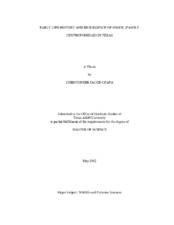| dc.description.abstract | The resurgence of Texas' snook (Family Centropomidae) recreational fishery is coupled with an uncertainty as to what species occur in State waters, a limited understanding of life history, and habitat needs of its constituents. This study described species composition and early life history aspects of juvenile (< 100 mm SL) centropomids taken in bag seine collections in estuarine and freshwater habitats along the upper, middle, and lower coast of Texas during 2006 to 2010. Centropomus specimens (n = 548) captured from 41 locations across the Texas coast as well as congeners from Mexico (n = 24), Florida (n = 7), and Costa Rica (n = 3) were used in a genetics- and meristic-based determination of species composition, growth rates, range of hatching dates, geographic distribution, and habitat association.
Genetic analyses of the mitochondrial DNA 16s ribosomal RNA gene and the mitochondrial control region (D - loop) validated the presence of smallscale fat snook (C. parallelus Poey, 1860, n = 333), common snook (C. undecimalis Bloch 1792, n = 212) and Mexican snook (C. poeyi Chavez, 1961, n = 3) in Texas, with the last of these validations representing the first known record of this species in Texas. AMOVA of 16s and D - loop sequences failed to detect genetic differentiation within Texas for C. parallelus and C. undecimalis. However, AMOVA for 16s and D - loop C. undecimalis sequences did yield significant genetic differences between Texas and Mexico against those from Florida and Costa Rica.
Juvenile centropomids (< 100 mm SL) in Texas occupied backwater habitats with dissipated currents similar to those of Florida congeners (tidal sloughs, freshwater habitats, and structured shorelines). Coastal ranges of these species differed with C. parallelus taken from the Rio Grande to West Galveston Bay, whereas C. undecimalis was captured from the Rio Grande northward near Palacios. Three C. poeyi were captured at only two locations (Laguna Vista and Port Aransas). Daily growth rates varied between species and capture years, with these ranging from 0.22 to 0.97 mm d^-1. Analyses of hatch-date distribution suggest centropomids in Texas begin spawning in August and continue it through late September into mid-November. | en |


